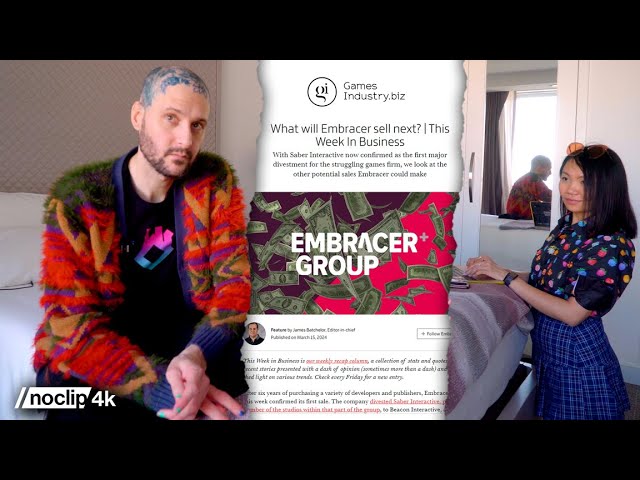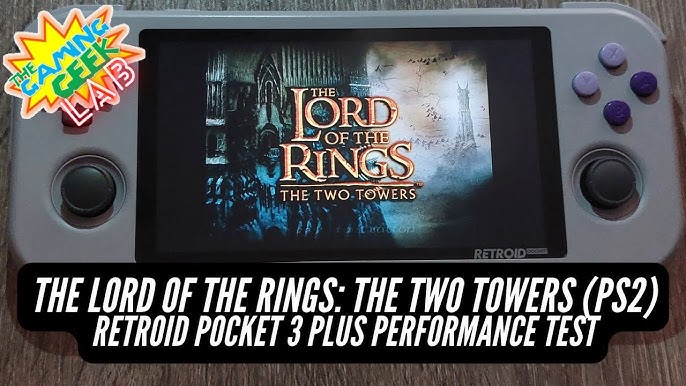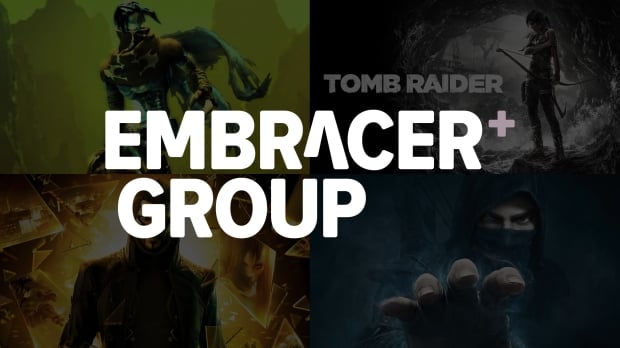Embracer Group Restructuring: A Game Dev Insider's Take on the Debt Crisis Embracer Group's restructuring plan, announced in June 2023, has sent shockwaves through the gaming industry.

Embracer Group's restructuring plan, announced in June 2023, has sent shockwaves through the gaming industry. What began as an ambitious acquisition spree has morphed into a frantic effort to reduce debt and streamline operations. As a seasoned game development insider, I've witnessed firsthand the impact these changes are having on studios and developers. The Embracer Group restructuring is not just a financial story; it's a human story, and its effects will be felt for years to come. This article breaks down the key elements of the crisis, from disappointing organic net sales growth to the controversial sale of Saber Interactive, providing context and analysis for PC gaming enthusiasts and industry followers.
A faded Embracer Group logo symbolizes the challenges the company currently faces, with its once-bright future now dimmed by financial pressures and restructuring efforts.
Organic Net Sales: A Rocky Road
Embracer Group's quest to become a gaming behemoth hit a major snag when a $2 billion deal fell through. This triggered a large restructuring program and left the company scrambling to right the ship. One of the most telling signs of the trouble came in the form of sluggish organic net sales growth.
According to Embracer's official quarterly reports, Q4 2023 and Q1 2024 presented a mixed bag, but ultimately didn't deliver the growth expected. While some segments showed promise, overall organic net sales struggled. You can view these reports and more on the official Embracer Group Investor Relations page. The absence of substantial organic growth put immense pressure on Embracer to find other ways to reduce its considerable debt burden.
Digging into the Numbers
The devil is always in the details. While specific figures fluctuate depending on the reporting period, the trend is clear: internal growth wasn't keeping pace with the company's ambitious expansion. This highlighted a core problem: relying too heavily on acquisitions rather than nurturing organic development within existing studios.
 Screenshots from various Embracer Group games, like Dead Island 2 and others, arranged in a montage to showcase the breadth of their portfolio, while a slight blur emphasizes the distant nature of the content.
Screenshots from various Embracer Group games, like Dead Island 2 and others, arranged in a montage to showcase the breadth of their portfolio, while a slight blur emphasizes the distant nature of the content.
The Weight of Debt: A Race Against Time
The primary driver of Embracer's restructuring is its need to drastically reduce its net debt. The company has publicly stated ambitious net debt reduction targets, aiming to significantly decrease its financial obligations within a relatively short timeframe. The clock is ticking, and the pressure to deliver is immense.
How Much Debt Needs to Go?
While specific targets may shift based on market conditions and divestment strategies, the general consensus is that Embracer needs to shed a significant portion of its debt – hundreds of millions of dollars – within the next fiscal year. This is no small feat, and it requires a multi-pronged approach, including asset sales, cost-cutting measures, and a renewed focus on profitability.
Saber Interactive Divestment: A Necessary Sacrifice?
One of the most significant moves in Embracer's restructuring plan was the decision to divest Saber Interactive. This $500 million deal included the sale of several studios, marking a major shift in Embracer's overall strategy.
 A subtly transparent overlay of the EMBRAC B stock chart illustrating the downward trend, positioned in the foreground to highlight the financial impact of the restructuring.
A subtly transparent overlay of the EMBRAC B stock chart illustrating the downward trend, positioned in the foreground to highlight the financial impact of the restructuring.
Which Studios Were Involved?
The Saber Interactive sale included not only Saber itself but also several other studios that had become part of the Embracer family through acquisitions. These studios contributed significantly to Embracer's portfolio, making the decision to sell them all the more difficult.
Financial Impact and Projections
The sale of Saber Interactive is projected to have a substantial impact on Embracer's cash flow and debt reduction strategy. The immediate influx of $500 million provides a much-needed boost to the company's balance sheet, allowing it to address some of its most pressing financial obligations. However, it also means losing the revenue generated by Saber and its associated studios. The long-term impact remains to be seen.
Lord of the Rings: From Fantasy to Reality Check
Embracer Group's acquisition of the Lord of the Rings and The Hobbit IP rights was initially hailed as a major coup. The potential for new games based on these beloved franchises seemed limitless. However, the financial performance of these games since the acquisition has been mixed, to say the least.
Gollum's Stumble: A Missed Opportunity
The release of Lord of the Rings: Gollum was a particularly painful example of how things can go wrong. The game was widely panned by critics and players alike, failing to meet sales expectations and damaging the reputation of the IP. This underscored the risk of relying too heavily on established franchises without ensuring quality and innovation.
Comparing Expectations vs. Reality
While Embracer undoubtedly hoped for blockbuster success with its Lord of the Rings games, the reality has been far more challenging. The financial return has fallen short of initial expectations, forcing the company to re-evaluate its strategy for leveraging these valuable IP rights.
 A partially broken PC game controller is shown in the lower right corner, symbolizing the struggles within the industry, partially obscured by shadows to convey realism.
A partially broken PC game controller is shown in the lower right corner, symbolizing the struggles within the industry, partially obscured by shadows to convey realism.
Cost-Cutting Measures: The Human Cost
The need to reduce debt has forced Embracer to implement significant cost-cutting measures, including studio closures and project cancellations. These decisions have had a devastating impact on game developers, resulting in layoffs and uncertainty within the company.
Studio Closures and Layoffs: Specific Examples
Several studios within the Embracer Group umbrella have been shuttered, and numerous projects have been canceled. IGN and other gaming news publications have reported extensively on these closures, highlighting the human cost of the restructuring. For example, the closure of Campfire Cabal made news across many gaming sites. These cuts have resulted in talented developers losing their jobs and promising games being shelved indefinitely.
Impact on Game Development
The ongoing restructuring is undoubtedly impacting game development within Embracer's remaining studios. Morale is low, and developers are concerned about their job security. This can lead to decreased productivity and a reluctance to take risks, ultimately affecting the quality and innovation of future games.
 A faded Embracer logo paired with a transparent stock chart in a downward trend to emphasize the company's current state of decline, suggesting the impact on investors.
A faded Embracer logo paired with a transparent stock chart in a downward trend to emphasize the company's current state of decline, suggesting the impact on investors.
Lars Wingefors' Accountability: Taking Responsibility?
CEO Lars Wingefors has faced increasing scrutiny regarding his role in Embracer's financial troubles. Investors and the gaming community alike are demanding accountability for the company's current situation.
Public Statements and Investor Presentations
Wingefors has made public statements and presented to investors, attempting to address the concerns raised by the restructuring. However, some critics argue that his statements have been insufficient, failing to fully acknowledge the severity of the situation and the mistakes that led to it.
Addressing Concerns: Has He Done Enough?
Whether Wingefors has adequately addressed the concerns remains a subject of debate. While he has taken steps to rectify the situation, the road ahead is long and challenging. Many believe that more transparency and a more concrete plan for the future are needed to restore confidence in Embracer's leadership.
Expert Insight: The Financial Analyst's Perspective
To gain a deeper understanding of Embracer's financial situation, I spoke with an anonymous financial analyst specializing in media conglomerates who have overextended in acquisitions. Their insights provide valuable context and perspective on the challenges facing Embracer Group.
Key Performance Indicators (KPIs) for Success
According to the analyst, the top three KPIs investors should be watching are:
- Debt Reduction Rate: "The speed at which Embracer is able to reduce its net debt is critical. Investors need to see tangible progress in this area."
- Organic Revenue Growth (ex-LOTR): "Excluding the volatile LOTR IP, can Embracer demonstrate sustainable revenue growth from its remaining portfolio? This will indicate the underlying health of the business."
- Profit Margin Improvement: "Cutting costs is important, but ultimately, Embracer needs to improve its profit margins. This requires efficient operations and successful game releases."
Embracer's Debt Level Compared
"Embracer's current debt level is high compared to similar companies undergoing financial restructuring. However, the company has valuable assets that it can potentially leverage to reduce its debt," the analyst noted.
The Biggest Risk
"The biggest risk to Embracer achieving its stated financial goals is the possibility of further game development failures or a prolonged period of weak sales. This could derail the entire restructuring plan," the analyst warned.
A Credible Future?
"Based on publicly available information, there is a credible future for Embracer, but it will require disciplined execution and a willingness to make tough decisions. The company needs to focus on its core strengths and avoid overextending itself again," the analyst concluded.
 A blurred screenshot montage emphasizing the fragmentation of assets and hinting at the internal challenges in media conglomerate operations.
A blurred screenshot montage emphasizing the fragmentation of assets and hinting at the internal challenges in media conglomerate operations.
Stock Analysis (EMBRAC B: Stockholm): Navigating the Volatility
Analyzing the Embracer Group stock analysis (EMBRAC B: Stockholm) is a crucial aspect of understanding the company's current situation. Recent analyst ratings and price targets reflect the uncertainty surrounding Embracer's future.
Analyst Ratings and Price Targets
Analyst ratings for Embracer Group vary, with some expressing cautious optimism while others remain skeptical. Price targets have been adjusted downward to reflect the company's financial challenges. These ratings are correlated with Embracer's progress in restructuring, with positive news potentially leading to upgrades and vice versa.
Disclaimer: This is NOT financial advice. The following is a summary of available analyst opinions and should not be taken as a recommendation to buy or sell Embracer Group stock. Always consult with a qualified financial advisor before making investment decisions.
 The image depicts a financial analyst's workstation, complete with multiple monitors and a stock chart displayed, to emphasize market unpredictability.
The image depicts a financial analyst's workstation, complete with multiple monitors and a stock chart displayed, to emphasize market unpredictability.
What is Embracer Group doing to cut costs?
Embracer Group is implementing several cost-cutting measures:
- Studio closures and project cancellations to reduce operational overhead.
- Divesting assets like Saber Interactive to decrease debt.
- Implementing efficiency improvements across remaining studios.
Conclusion: A Long Road Ahead
The Embracer Group debt crisis and subsequent restructuring is a complex and evolving situation. While the company has taken steps to address its financial challenges, the road ahead is long and uncertain. The impact on game developers, studios, and the gaming community as a whole is undeniable. Investors will be closely monitoring Embracer's progress in reducing debt, improving profitability, and delivering quality games. For continued, in-depth coverage of Embracer Group and the gaming industry, subscribe to XenGamer today.
 This image illustrates the game industry restructuring, with elements suggesting both the financial aspects and the human impact of the changes within the gaming sector.
This image illustrates the game industry restructuring, with elements suggesting both the financial aspects and the human impact of the changes within the gaming sector.
 The image shows a partially broken PC game controller in the shadows symbolizing struggles in the gaming industry.
The image shows a partially broken PC game controller in the shadows symbolizing struggles in the gaming industry.